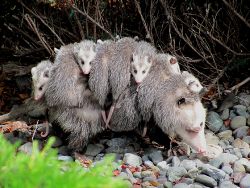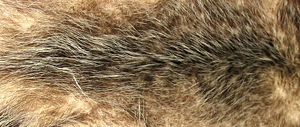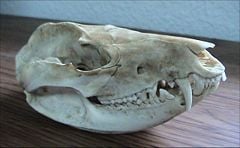Opossum
| Didelphimorphia[1]
| ||||||||||||
|---|---|---|---|---|---|---|---|---|---|---|---|---|
 Virginia Opossum Didelphis virginiana
| ||||||||||||
| Scientific classification | ||||||||||||
| ||||||||||||
|
Several; see text |

Opossum is the common name for various small- to medium-sized marsupials comprising the mammalian order Didelphimorphia and found in the Western Hemisphere. Opossums, of which there are more than 60 species, are characterized by a long, naked tail; a long, pointed snout; opposable thumbs in the hands and feet; and ears that are naked (Grzimek et al. 2004). Most are arboreal and nocturnal. They are found from southern Canada in North America to Argentina and Chile in South America. The Virginia opossum (Didelphis virginiana), the original animal named opossum, is the only marsupial native to North America north of Mexico.
Opossums offer values to the ecosystem and humans. Ecologically, they are part of the terrestrial food chain, consuming insects, fruits, small animals and other foods, while being preyed upon by coyotes, foxes, snakes, and birds of prey. For humans, opossums not only add to the wonder of natureâsuch as their act of playing dead ("play possum") when threatened, or the mothers carrying their young on their backsâbut also have been a traditional source of food.
A similar group of marsupial mammals belonging to the order Diprotodontia and suborder Phalangeriformes, and native to Australia, New Guinea, Sulawesi and introduced to New Zealand, are known by the common name of possum. The term possum also is used in North America as a diminutive for the Virginia opossum.
Overview
While most mammals are placentals, the opossum is a marsupial, belonging to the order (or infraclass) Marsupialia. Unlike placental mammals (Placentalia), almost all marsupials lack the placenta that connects the mother with the developing fetus in the womb. Some marsupials have a rudimentary placenta that functions for only a short time, such as the bandicoot. Marsupial females typically have an external pouch in which the immature young are raised after birth until early infancy. The newborn typically crawl to this pouch after birth, and attach themselves to milk-secreting teats (nipples), and are nursed until they can survive outside the pouch. This time period in the pouch is similar to the later stages of a placental mammal's development in the womb.
Marsupials also differ from placental mammals in their reproductive traits. The female has two vaginas (the tubular tract leading from the uterus to the exterior of the body). Both of the vaginas open externally through one orifice, but lead to different compartments within the uterus. Males usually have a two-pronged penis, which corresponds to the females' two vaginas. The penis only passes sperm. Marsupials have a cloaca (posterior opening that serves as the only such opening for the intestinal and urinary tracts) that is connected to a urogenital sac in both sexes. Waste is stored there before expulsion.
Besides the opossum, well-known marsupials include kangaroos, bandicoots, and wombats. Marsupials are native to Australia, New Guinea, Tasmania, and the Americas. Of the over 330 species of marsupials, most (over 200 species) are native to Australia and nearby islands to the north. Indeed, they are the dominant mammals in Australia, which have almost no native placental mammals. However, there also are many extant (living) marsupial species in South America, including the opossum.
The order Didelphimorphia, the opossums, include one extant family, Didelphidae. Opossums probably diverged from the basic South American marsupials in the late Cretaceous or early Paleocene. A sister group is Paucituberculata (shrew opossums). They are commonly also called "possums," though that term is also applied to Australian fauna of the suborder Phalangeriformes. Colloquially, the Virginia opossum is frequently called simply possum.
Description
Didelphimorphs are small to medium-sized marsupials, with the larger ones about the size of a large house cat. They range from 8 to 55 centimeters (3-22 inches) in length, and 25 to 5000 grams (0.9 ounces to 11 pounds) (Grzimek et al. 2004). Most members of this taxon have long snouts, a narrow braincase, and a prominent sagittal crest. The dental formula (one side of one jaw) includes five incisors (four on the lower jaw), one canine, three premolars, and four tricuspid molars. By mammal standards, this is a very full jaw. The incisors are very small, the canines large.
Didelphimorphs have a plantigrade stance (feet flat on the ground) and the hind feet have an opposable digit with no claw. Like some primates, opossums have prehensile tails. The stomach is simple, with a small cecum. Opossum reproductive systems are extremely basic, with a reduced marsupium. This means that the young are born at a very early stage. The species are moderately sexually dimorphic with males usually being somewhat larger than females. The largest difference between the opossum and other sexually reproductive animals in the Americas is the bifurcated penis of the male and bifurcated vagina of the female.
Opossums have colors that vary from nearly pure white to blackish, with some species one color and others with distinct light and dark bands (Grzimek et al. 2004).
Opossums have a remarkably robust immune system, and show partial or total immunity to the venom of rattlesnakes, cottonmouths, and other pit vipers (WRL 2007; Lipps 1999). Thanks to their lower blood temperature, rabies is almost unknown in opossums (OSUS 2003). The opossum lifespan is unusually short for a mammal of its size, usually only two to four years. Senescence is rapid (NOS 2006).
The opossum was described as early as 1565 in the published letter entitled "Carigueya, Seu Marsupiale Americanum Masculum. Or, The Anatomy of a Male Opossum: In a Letter to Dr Edward Tyson, from Mr William Cowper, Chirurgeon, and Fellow of the Royal Society, London. To Which are Premised Some Further Observations on the Opossum; And a New Division of Terrestrial Brute Animals, Particularly of Those That Have Their Feet Formed Like Hands. Where an Account is Given of Some Animals Not Yet Described." The letter suggests even earlier descriptions (Langworthy 1932).
Distribution, diet, and behavior
Opossums tend to be semi-arboreal omnivores, although there are many exceptions. Typically, they are opportunistic omnivores with a very broad range of diet, including insects, fruit, small animals, grains, and eggs. Their unspecialized biology, flexible diet, and reproductive strategy make them successful colonizers and survivors in unsettled times. Originally native to the eastern United States, the Virginia opossum was intentionally introduced into the west during the Great Depression, probably as a source of food. Its range has been expanding steadily northwards, thanks in part to more plentiful, man-made sources of fresh water, increased shelter due to urban encroachment, and milder winters. Its range has extended into Ontario, Canada, and it has been found farther north than Toronto. The common opossum, Didelphis marsupialis,, is believed to have moved into the southern United States from Mexico.
Opossums are usually nomadic, staying in one area as long as food and water are easily available. Though they will temporarily occupy abandoned burrows, they do not dig or put much effort into building their own. They favor dark, secure areas, below ground or above.
When threatened or harmed, they will "play possum," mimicking the appearance and smell of a sick or dead animal. The lips are drawn back, teeth are bared, saliva foams around the mouth, and a foul-smelling fluid is secreted from the anal glands. The physiological response is involuntary, rather than a conscious act. Their stiff, curled form can be prodded, turned over, and even carried away. Many injured opossums have been killed by well-meaning people who find a catatonic animal and assume the worst. The best thing to do upon finding an injured or apparently dead opossum is to leave it in a quiet place with a clear exit path. In minutes or hours, the animal will regain consciousness and escape quietly on its own.
Adult opossums do not hang from trees by their tails, though babies may dangle temporarily. Their prehensile tails are not strong enough to support a mature adult's weight, though they often serve as a brace and a fifth limb when climbing. There are also confirmed accounts of the tail being used as a grip to carry bunches of leaves or bedding materials to the nest. A mother will sometimes carry her young upon her back, where they will cling tightly even when she is running across the ground or climbing.
Use as food
The opossum was a favorite game animal in the United States, and in particular the southern regions, which have a large body of recipes and folklore relating to the opossum. That opossum was once widely consumed in the United States where available is evidenced by recipes in earlier editions of The Joy of Cooking. In Dominica and Trinidad, opossum or "manicou" is popular and can only be hunted during certain times of the year due to over-hunting; the meat is traditionally prepared by smoking then stewing. The meat is light and fine grained and the musk glands must be removed as part of preparation. The meat can be used in place of rabbit and chicken in recipes. The cousin of the opossum, the possum, found in Australia and New Zealand, is consumed in a similar manner (Davidson 1999).
Historically, hunters in the Caribbean would place a barrel with fresh or rotten fruit to attract opossums who would feed on the fruit or insects attracted to the fruit. Cubans growing up in the mid-twentieth century tell of brushing the maggots out of the mouths of "manicou" caught in this manner to prepare them for consumption.
In Mexico, opossums are known as "tlacuache" or "tlaquatzin." Their tails are eaten as a folk remedy to improve fertility (most likely because they have many babies that they store in their pouch).
Opossum oil (possum grease) is high in essential fatty acids and has been used as a chest rub and a carrier for arthritis remedies given as topical salves.
Classification
Grzimek et al. recognize 15 genera and 61 species. The following classification by Gardner (2005) recognizes 19 genera and 91 species.
- Family Didelphidae[1]
- Subfamily Caluromyinae
- Genus Caluromys
- Subgenus Mallodelphys
- Derby's Woolly Opossum, Caluromys derbianus
- Brown-eared Woolly Opossum, Caluromys lanatus
- Subgenus Caluromys
- Bare-tailed Woolly Opossum, Caluromys philander
- Subgenus Mallodelphys
- Genus Caluromysiops
- Black-shouldered Opossum, Caluromysiops irrupta
- Genus Glironia
- Bushy-tailed Opossum, Glironia venusta
- Genus Caluromys
- Subfamily Didelphinae
- Genus Chacodelphys
- Chacoan Pygmy Opossum (Chacodelphys formosa)
- Genus Chironectes
- Yapok or Water Opossum (Chironectes minimus)
- Genus Cryptonanus
- Agricola's Gracile Opossum (Cryptonanus agricolai)
- Chacoan Gracile Opossum (Cryptonanus chacoensis)
- Bolivian Gracile Opossum (Cryptonanus guahybae)
- Red-bellied Gracile Opossum (Cryptonanus ignitus)
- Rio Grande do Sul Gracile Opossum (Cryptonanus unduaviensis)
- Genus Didelphis
- White-eared Opossum (Didelphis albiventris)
- Big-eared Opossum (Didelphis aurita)
- Guianan White-eared Opossum (Didelphis imperfecta)
- Common Opossum (Didelphis marsupialis)
- Andean White-eared Opossum (Didelphis pernigra)
- Virginia Opossum (Didelphis virginiana)
- Genus Gracilinanus
- Aceramarca Gracile Opossum (Gracilinanus aceramarcae)
- Agile Gracile Opossum (Gracilinanus agilis)
- Wood Sprite Gracile Opossum (Gracilinanus dryas)
- Emilia's Gracile Opossum (Gracilinanus emilae)
- Northern Gracile Opossum (Gracilinanus marica)
- Brazilian Gracile Opossum (Gracilinanus microtarsus)
- Genus Hyladelphys
- Kalinowski's Mouse Opossum (Hyladelphys kalinowskii)
- Genus Lestodelphys
- Patagonian Opossum (Lestodelphys halli)
- Genus Lutreolina
- Lutrine or Thick-tailed Opossum (Lutreolina crassicaudata)
- Genus Marmosa
- Heavy-browed Mouse Opossum (Marmosa andersoni)
- Rufous Mouse Opossum (Marmosa lepida)
- Mexican Mouse Opossum (Marmosa mexicana)
- Linnaeus's Mouse Opossum (Marmosa murina)
- Quechuan Mouse Opossum (Marmosa quichua)
- Robinson's Mouse Opossum (Marmosa robinsoni)
- Red Mouse Opossum (Marmosa rubra)
- Tyleria Mouse Opossum (Marmosa tyleriana)
- Guajira Mouse Opossum (Marmosa xerophila)
- Genus Marmosops
- Bishop's Slender Opossum (Marmosops bishopi)
- Narrow-headed Slender Opossum (Marmosops cracens)
- Marmosops creightoni
- Dorothys' Slender Opossum (Marmosops dorothea)
- Dusky Slender Opossum (Marmosops fuscatus)
- Handley's Slender Opossum (Marmosops handleyi)
- Tschudi's Slender Opossum (Marmosops impavidus)
- Gray Slender Opossum (Marmosops incanus)
- Panama Slender Opossum (Marmosops invictus)
- Junin Slender Opossum (Marmosops juninensis)
- Neblina Slender Opossum (Marmosops neblina)
- White-bellied Slender Opossum (Marmosops noctivagus)
- Delicate Slender Opossum (Marmosops parvidens)
- Brazilian Slender Opossum (Marmosops paulensis)
- Pinheiro's Slender Opossum (Marmosops pinheiroi)
- Genus Metachirus
- Brown Four-eyed Opossum (Metachirus myosuros)
- Genus Micoureus
- Alston's Mouse Opossum (Micoureus alstoni)
- White-bellied Woolly Mouse Opossum (Micoureus constantiae)
- Woolly Mouse Opossum (Micoureus demerarae)
- Tate's Woolly Mouse Opossum (Micoureus paraguayanus)
- Little Woolly Mouse Opossum (Micoureus phaeus)
- Bare-tailed Woolly Mouse Opossum (Micoureus regina)
- Genus Monodelphis
- Sepia Short-tailed Opossum (Monodelphis adusta)
- Northern Three-striped Opossum (Monodelphis americana)
- Northern Red-sided Opossum (Monodelphis brevicaudata)
- Yellow-sided Opossum (Monodelphis dimidiata)
- Gray Short-tailed Opossum (Monodelphis domestica)
- Emilia's Short-tailed Opossum (Monodelphis emiliae)
- Amazonian Red-sided Opossum (Monodelphis glirina)
- Ihering's Three-striped Opossum (Monodelphis iheringi)
- Pygmy Short-tailed Opossum (Monodelphis kunsi)
- MarajĂł Short-tailed Opossum (Monodelphis maraxina)
- Osgood's Short-tailed Opossum (Monodelphis osgoodi)
- Hooded Red-sided Opossum (Monodelphis palliolata)
- Monodelphis reigi
- Peruvian Short-tailed Opossum (Monodelphis ronaldi)
- Chestnut-striped Opossum (Monodelphis rubida)
- Long-nosed Short-tailed Opossum (Monodelphis scalops)
- Southern Red-sided Opossum (Monodelphis sorex)
- Southern Three-striped Opossum (Monodelphis theresa)
- Red Three-striped Opossum (Monodelphis umbristriata)
- One-striped Opossum (Monodelphis unistriata)
- Genus Philander
- Anderson's Four-eyed Opossum (Philander andersoni)
- Philander deltae
- Southeastern Four-eyed Opossum (Philander frenatus)
- McIlhenny's Four-eyed Opossum (Philander mcilhennyi)
- Philander mondolfii
- Gray Four-eyed Opossum (Philander opossum)
- Genus Thylamys
- Cinderella Fat-tailed Mouse Opossum (Thylamys cinderella)
- Elegant Fat-tailed Mouse Opossum (Thylamys elegans)
- Karimi's Fat-tailed Mouse Opossum (Thylamys karimii)
- Paraguayan Fat-tailed Mouse Opossum (Thylamys macrurus)
- White-bellied Fat-tailed Mouse Opossum (Thylamys pallidior)
- Common Fat-tailed Mouse Opossum (Thylamys pusillus)
- Argentine Fat-tailed Mouse Opossum (Thylamys sponsorius)
- Tate's Fat-tailed Mouse Opossum (Thylamys tatei)
- Dwarf Fat-tailed Mouse Opossum (Thylamys velutinus)
- Buff-bellied Fat-tailed Mouse Opossum (Thylamys venustus)
- Genus Tlacuatzin
- Gray Mouse Opossum (Tlacuatzin canescens)
- Genus Chacodelphys
- Subfamily Caluromyinae
Notes
- â 1.0 1.1 A. Gardner, "Order *," pages 3-18 in D. E. Wilson and D. M. Reeder, eds. Mammal Species of the World: A Taxonomic and Geographic Reference, 3rd edition. (Baltimore: Johns Hopkins University Press, 2005). ISBN 0801882214.
ReferencesISBN links support NWE through referral fees
- Cowper, W., and E. Tyson. 1704. Number 290: Carigueya, seu marsupiale Americanum masculum. Or, the anatomy of a male opossum: In a letter to Dr Edward Tyson, from Mr William Cowper, Chirurgeon, and Fellow of the Royal Society, London. To which are premised some further observations on the opossum; and a new division of terrestrial brute animals, particularly of those that have their feet formed like hands. Where an account is given of some animals not yet described]. Philosophical Transactions 2: 1565-1575.
- Davidson, A. 1999. Oxford Companion to Food. Oxford : Oxford University Press. ISBN 0192115790.
- Gardner, A. 2005. Page 3-18 in D. E. Wilson and D. M. Reeder (eds). Mammal Species of the World, 3rd edition. Johns Hopkins University Press. ISBN 0801882214.
- Geddes, B. 2001. World Food. Caribbean. Footscray, Vic: Lonely Planet. ISBN 1864503483.
- Grzimek, B., D. G. Kleiman, V. Geist, and M. C. McDade. 2004. Grzimek's Animal Life Encyclopedia. Detroit: Thomson-Gale, ISBN 0307394913.
- Langworthy, O. R. 1931. The panniculus carnosus and pouch musculature of the opossum, a marsupial. Journal of Mammalogy 13(3): 241-251.
- Lew, D., R. PĂ©rez-HernĂĄndez, and J. Ventura. 2006. Two new species of Philander (Didelphimorphia, Didelphidae) from northern South America. Journal of Mammalogy 87(2): 224â237.
- Lipps, B. V. 1999. Anti-lethal factor from opossum serum is a potent antidote for animal, plant, and bacterial toxins. Journal of Venomous Animals and Toxins 5(1). Retrieved October 2, 2007.
- National Opossum Society (NOS 2006). Opossum facts. National Opossum Society. Retrieved October 2, 2007.
- Opossum Society of the United States (OSUS). 2003. Frequently asked questions: Opossum problems and solutions. Opossum Society of the United States. Retrieved October 2, 2007.
- Wildlife Rescue League (WRL). 2007. The opossum: Our marvelous marsupial, the social loner. Wildlife Rescue League's Rescue Report. Retrieved October 2, 2007.
Credits
New World Encyclopedia writers and editors rewrote and completed the Wikipedia article in accordance with New World Encyclopedia standards. This article abides by terms of the Creative Commons CC-by-sa 3.0 License (CC-by-sa), which may be used and disseminated with proper attribution. Credit is due under the terms of this license that can reference both the New World Encyclopedia contributors and the selfless volunteer contributors of the Wikimedia Foundation. To cite this article click here for a list of acceptable citing formats.The history of earlier contributions by wikipedians is accessible to researchers here:
The history of this article since it was imported to New World Encyclopedia:
Note: Some restrictions may apply to use of individual images which are separately licensed.
